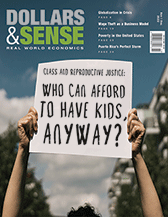This article is from Dollars & Sense: Real World Economics, available at http://www.dollarsandsense.org

This article is from the
November/December 2022 issue.
Subscribe Now
at a 30% discount.

Dr. Dollar
Puerto Rico’s Perfect Storm
Colonialism, Privatization, and Trump
In September 2017, Hurricane Maria devastated Puerto Rico. Almost exactly five years later, Hurricane Fiona did it again. The death toll from Fiona appears not so great as was the case with Maria, but both times the island was left in darkness, as the electric power grid failed. The economic recovery from Maria was slow, and the economic impact of Fiona is likely to match that prior experience.
It is easy to view these two tragedies as “natural” disasters, but, of course, only if one ignores the fact that human-generated global warming has contributed to the frequency of severe hurricanes. In any case, the hurricanes’ causes aside, the impact on Puerto Rico is the consequence of an even greater perfect storm: the effects of Puerto Rico’s 100-plus years as a U.S. colony (following centuries of colonial rule by Spain); the damage wrought by the recent privatization of its electric power grid; and the legacy of the Trump administration’s reaction following Maria.
Colonialism
Puerto Rico, like other colonies, has been administered in the interests of the “mother country.” (See Puerto Rico’s Colonial Economy, D&S, November/December 2015.) This has meant, for example, providing generous tax advantages for U.S. firms operating on the island, delivering little benefit to Puerto Ricans but substantial profits for the firms; requiring that goods shipped from U.S. ports to Puerto Rico go on ships owned and operated by U.S. firms; controlling Puerto Rico’s economic relations with the rest of the world; and sharply repressing efforts to build an independence movement on the island.
But most of all, the colonial domination of Puerto Rico by the United States has created a dependency that shapes economics and politics on the island. Policymakers in Puerto Rico look off the island for sources of investment and for favors from Washington, D.C. Consequently, Puerto Rico has failed to develop the internal foundations for economic growth and has no strong business class and limited skilled labor. As Associate Supreme Court Justice Sonia Sotomayor put it in her 1976 senior thesis at Princeton University: The economic growth of Puerto Rico in the 1950s and 1960s “was based on a negation of self- sufficiency and an acceptance of utter dependency on the colonial master, the United States.”
This colonial dependence created a government that was often corrupt and lacked competence. It was outward looking, and unable to build structures that would support the internal economy. Most important, when the hurricanes hit, the electric power system—both before and after its privatization—has been a costly, poorly operated burden on the economy.
(The U.S. government has long claimed that Puerto Rico is not a “colony” but an “unincorporated territory” of the United States. Yet, by any reasonable definition of the term, the island’s colonial status is clear. Moreover, the U.S. government’s 2016 establishment of the Financial Oversight and Management Board (FOMB)—called “La Junta” in Puerto Rico—to oversee the island’s economy underscored its colonial status.)
Privatization
The Puerto Rico Electric Power Authority (PREPA) was created in the early 1940s, a state-owned monopoly that controlled the generation, transmission, and distribution of electricity throughout the island. In a 2005 paper, Sergio M. Marxuach, policy director at the Center for the New Economy in Puerto Rico, points out the provisions in the act creating PREPA:
[The act] charters PREPA as a vertically integrated, self-regulated, tax-exempt, publicly owned monopoly with broad powers to issue regulations that govern its business and to set rates at which its services must be purchased by its clients.
While PREPA did have success in supporting economic growth in the 1950s and 1960s and bringing electricity to all corners of the island, there is little, if any, reason to think that a self-regulated monopoly would be an effective provider of power. It increasingly became inefficient, charged high rates, provided poor service, and lost money. Its borrowing was a major contribution to the Puerto Rican debt crisis; PREPA declared bankruptcy in mid-2017.
With PREPA’s failures, after the Maria tragedy, the Puerto Rican government could have, at least in theory, reformed the public provision of electricity by: overhauling PREPA; breaking the island’s single grid into a set of separate grids (so a breakdown in one area would not pitch the whole island into darkness); supporting green, efficient energy generation; and establishing meaningful, continuing regulation. This is not what happened.
Instead, the government, backed by the FOMB, turned to privatization, contracting in June 2021 with LUMA Energy, a joint operation of a Canadian and a U.S. firm, to take over the management of the power grid. With PREPA still responsible for electricity generation, the arrangement is dubbed a “public-private partnership.”
Neither in the years following Maria nor in the period since LUMA’s engagement have there been moves to break up the grid into separate grids and no action to move from imported fossil fuels to green energy. However, according to an article in The Americano’s Floricua newsletter on June 30, 2022, “Since the company [LUMA] took over operations on the island one year ago, rate increases and blackouts have been constant.” The rate grew by 17% over a year of LUMA’s operations:
As of July 1, Puerto Ricans will pay even more for electricity, after Puerto Rico’s Energy Bureau approved LUMA Energy’s seventh consecutive rate increase... With the new increase, a household that consumes 800 kilowatt-hours, will be charged a rate of 33 cents per kWh. According to the U.S. Energy Information Administration, the average rate for electricity in the U.S. is 14 cents per kWh.
According to a September 2022 report by the Institute for Energy Economics and Financial Analysis:
Five years after Hurricane Maria, the electrical system appears to be no closer to emerging from bankruptcy. LUMA Energy and the Puerto Rico Electric Power Authority disagree publicly over major issues. They have failed to make progress on reducing prices, improving the dismal track record of implementing savings initiatives, and producing a better budget. Service delivery has been noticeably worse, and the various financial and accounting problems that led up to the bankruptcy remain largely in place.
So much for privatization. Whether a public monopoly, or a private monopoly, or a “public-private partnership” monopoly, without effective oversight and regulation, this virtual disaster is what one would expect. The popular outcry in Puerto Rico should be no surprise. (See sidebar.)
Trump
Former President Donald Trump’s disdain for Puerto Rico is well-known, exemplified in 2017 by his throwing rolls of paper towels to a Puerto Rican crowd. Presumably he thought they could use the towels to mop up the mess left by Maria. Then there was his, apparently serious, suggestion that the United States trade Puerto Rico for Greenland (which had the side-impact of making it clear that Puerto Rico was a U.S.-owned colony, if anyone still doubted it). Then there was President Trump’s claim that there were relatively few deaths resulting from Maria, while reliable estimates reported 3,000 or more deaths. Less well-known, however, was that it took three years after Maria, until September 2020, for the Trump administration to approve the $9.6 billion of federal funds that had been allocated to rebuild Puerto Rico’s electrical grid. (About $3.4 billion has been added since.) This funding delay, along with the privatization and generally poor operation of the colonial government, virtually assured that the grid would not be ready when Fiona struck the island.
Still, while President Trump took the United States’ Puerto Rico policy to an extreme nadir, the U.S. government, through many administrations, has not treated the island well. None have given emphasis to removing Puerto Rico from its colonial status.
A Final Comment
Puerto Ricans are U.S. citizens, yet living in the colony of Puerto Rico, they do not vote for the U.S. president and have no voting representatives in the U.S. Congress. While the island remains a colony, regardless of what the U.S. government calls it, the people of Puerto Rico will continue to experience the economic deprivations and indignities that have been their lot for centuries.
Did you find this article useful? Please consider supporting our work by donating or subscribing.
